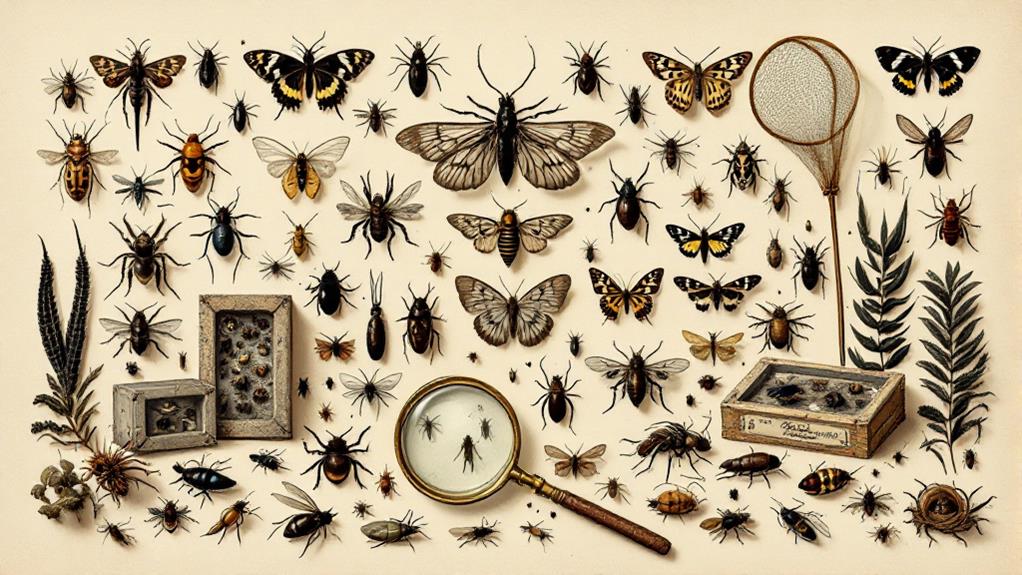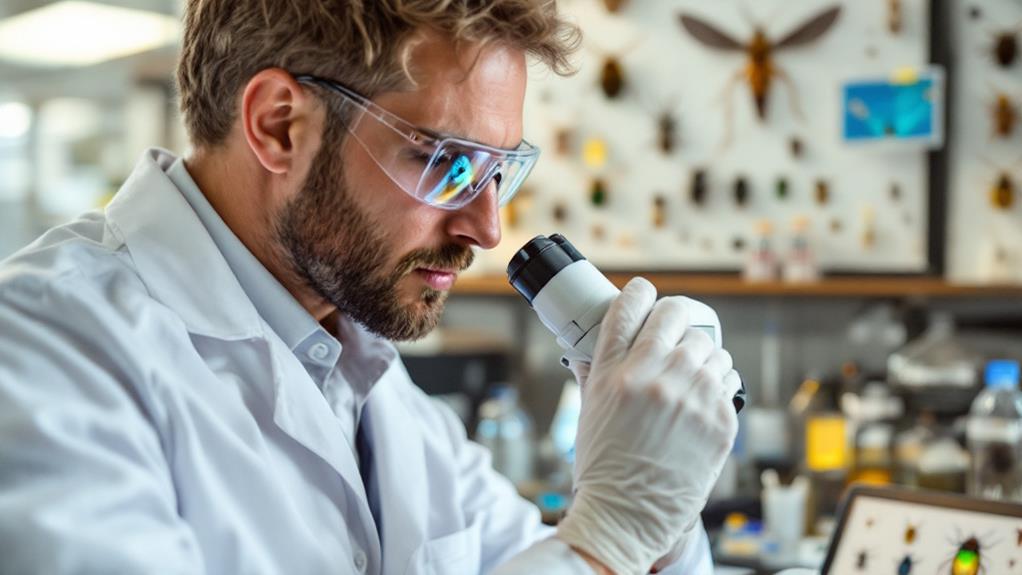The History of Entomology: Studying Insects and Their Impact on the World

Entomology's roots trace back to ancient civilizations observing insects in art and daily life. During the Renaissance, scientific inquiry led to rudimentary classification systems and early insect collections. The 18th century saw entomology emerge as a distinct discipline, with universities offering courses and specialized societies forming. You'll find that insects play essential roles in agriculture and medicine, from pollination to pest control. Modern research employs advanced technologies like DNA sequencing and high-speed imaging. Today, entomologists face challenges like climate change impacts and emerging diseases. As you investigate further, you'll uncover the intricate world of insects and their significant influence on our planet.
Ancient Observations of Insects

Three ancient civilizations laid the groundwork for early entomological studies. In ancient Egypt, you'd find depictions of insects in hieroglyphics and artwork, showcasing their cultural significance. The Egyptians observed insect behavior patterns, particularly in scarab beetles, which they associated with the sun god Ra.
Ancient Chinese civilization also made significant contributions to early entomology. They documented insect human interactions, especially in agriculture. You'll find records of silk production from silkworms dating back to 3000 BCE, demonstrating their understanding of insect life cycles and practical applications.
In ancient Greece, Aristotle's "Historia Animalium" provided detailed observations of various insects. He described their anatomy, behavior, and life stages, laying the foundation for systematic insect classification. You'd be impressed by his accurate descriptions of bees' social structure and reproduction.
These early observations weren't just academic pursuits. They had practical implications for agriculture, medicine, and cultural practices. By studying insect behavior patterns and their interactions with humans, these ancient civilizations began to explore the complex relationships between insects and their environment, setting the stage for future entomological research.
Insects in Early Scientific Inquiry
As ancient civilizations laid the groundwork, the Renaissance period marked a shift towards more systematic scientific inquiry into insects. You'll find that early scientists began developing rudimentary insect classification systems, attempting to organize the vast diversity of these creatures. They'd collect specimens, preserving them for study and comparison.
Notable figures like Ulisse Aldrovandi and Thomas Moffet emerged, dedicating their lives to observing and documenting insect behavior, anatomy, and life cycles. Their work laid the foundation for future entomologists.
Early insect collections grew in popularity, with naturalists and hobbyists alike contributing to the expanding knowledge base. These collections served as irreplaceable resources for studying:
- Insect morphology
- Species diversity
- Geographic distribution
- Seasonal variations
- Evolutionary relationships
As scientific methods evolved, so did the approach to studying insects. You'd see the emergence of more sophisticated tools and techniques, such as microscopy, which allowed for detailed examination of insect anatomy. This period of early scientific inquiry set the stage for the modern field of entomology, paving the way for pioneering discoveries and a deeper understanding of these fascinating creatures.
Entomology's Rise as a Discipline

Entomology's metamorphosis into a distinct scientific discipline began in the 18th century. You'll find that this period marked a significant shift in how insects were studied and perceived. As the Age of Enlightenment dawned, scientists began to recognize the importance of systematic classification and detailed observation in understanding the natural world.
Early academic recognition came with the establishment of entomology courses at universities. You'd see growing scientific interest as more researchers dedicated their careers to studying insects. This led to the formation of specialized societies and the publication of journals focused solely on entomological research.
You'll notice that entomologists of this era made innovative discoveries about insect anatomy, behavior, and life cycles. They developed new collection and preservation techniques, allowing for more extensive studies. As the field expanded, you'd find entomologists collaborating with other scientists, recognizing the interconnectedness of insects with agriculture, medicine, and ecology.
Insects in Agriculture and Medicine
The impact of insects on agriculture and medicine became a central focus for entomologists in the 19th and 20th centuries. You'll find that researchers began to uncover the intricate relationships between insects and crops, as well as their potential in medical applications. They discovered both beneficial insect relationships and the need for detrimental pest management.
In agriculture, entomologists identified crucial pollinators and natural predators that help maintain ecosystem balance. They also developed strategies to combat crop-destroying pests, leading to more efficient farming practices. In medicine, insects provided inspiration for new treatments and became valuable tools in forensic investigations.
As you investigate this field, you'll encounter fascinating examples of insects' roles:
- Honeybees pollinating vast orchards of fruit trees
- Ladybugs devouring aphids in vegetable gardens
- Maggots cleaning wounds in medical settings
- Silkworms producing materials for surgical sutures
- Mosquitoes transmitting diseases like malaria
These discoveries revolutionized our understanding of insects' impact on human life. Entomologists continue to examine new ways to utilize beneficial insect relationships while developing innovative approaches to pest management, ensuring a balance between human needs and ecological preservation.
Modern Entomological Research Methods

Modern entomological research methods have revolutionized the field, equipping scientists with state-of-the-art tools to study insects like never before. You'll find that advances in technology have greatly enhanced our ability to observe, analyze, and understand insect behavior, physiology, and genetics.
One of the most significant developments is the use of sophisticated insect rearing techniques. These allow researchers to maintain controlled populations for extended studies, ensuring consistent results and reducing the need for field collection. You can now precisely manipulate environmental factors like temperature, humidity, and diet to observe their effects on insect development and behavior.
Field observation protocols have also evolved dramatically. You'll see entomologists using high-speed cameras, thermal imaging, and remote sensing technologies to capture insect activities in their natural habitats. These tools provide unparalleled viewpoints into insect flight patterns, mating behaviors, and ecosystem interactions.
Molecular techniques, such as DNA sequencing and gene editing, have opened up new avenues for studying insect evolution and developing targeted pest control methods. You can now analyze insect genomes to understand their adaptations and resistance mechanisms, forging the way for more effective and environmentally friendly pest management strategies.
Future Challenges in Entomology
Numerous challenges await entomologists in the coming decades as they grapple with the effects of climate change, habitat loss, and emerging diseases on insect populations. You'll find that climate change impacts are already altering insect behavior, distribution, and life cycles. As temperatures rise, you'll observe shifts in species ranges and changes in pest outbreaks, potentially affecting agriculture and ecosystems worldwide.
Disease vector monitoring will become increasingly indispensable as insects like mosquitoes expand their territories, potentially spreading pathogens to new regions. You'll need to develop innovative strategies to track and control these vectors while minimizing environmental impacts.
As an entomologist, you'll face complex challenges that require interdisciplinary approaches:
- Untangling insect-microbiome interactions
- Developing sustainable pest management techniques
- Preserving pollinator populations
- Exploring insect-inspired technologies
- Investigating insect adaptations to environmental stressors
You'll need to collaborate with experts in genetics, ecology, and data science to tackle these issues effectively. The future of entomology will demand creative solutions to address the rapidly changing world of insects and their impact on human health, food security, and biodiversity conservation.



